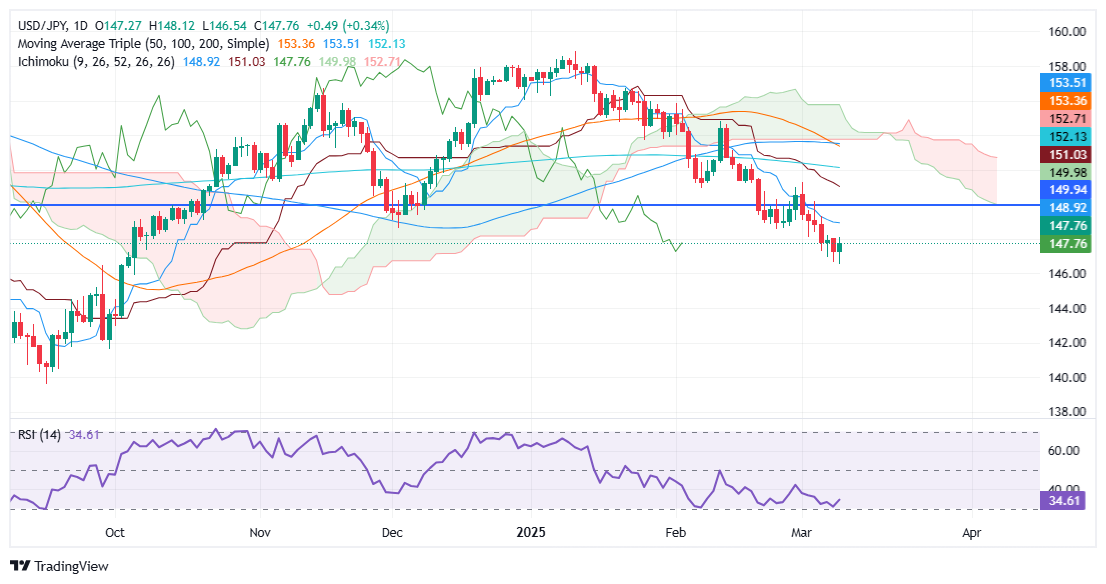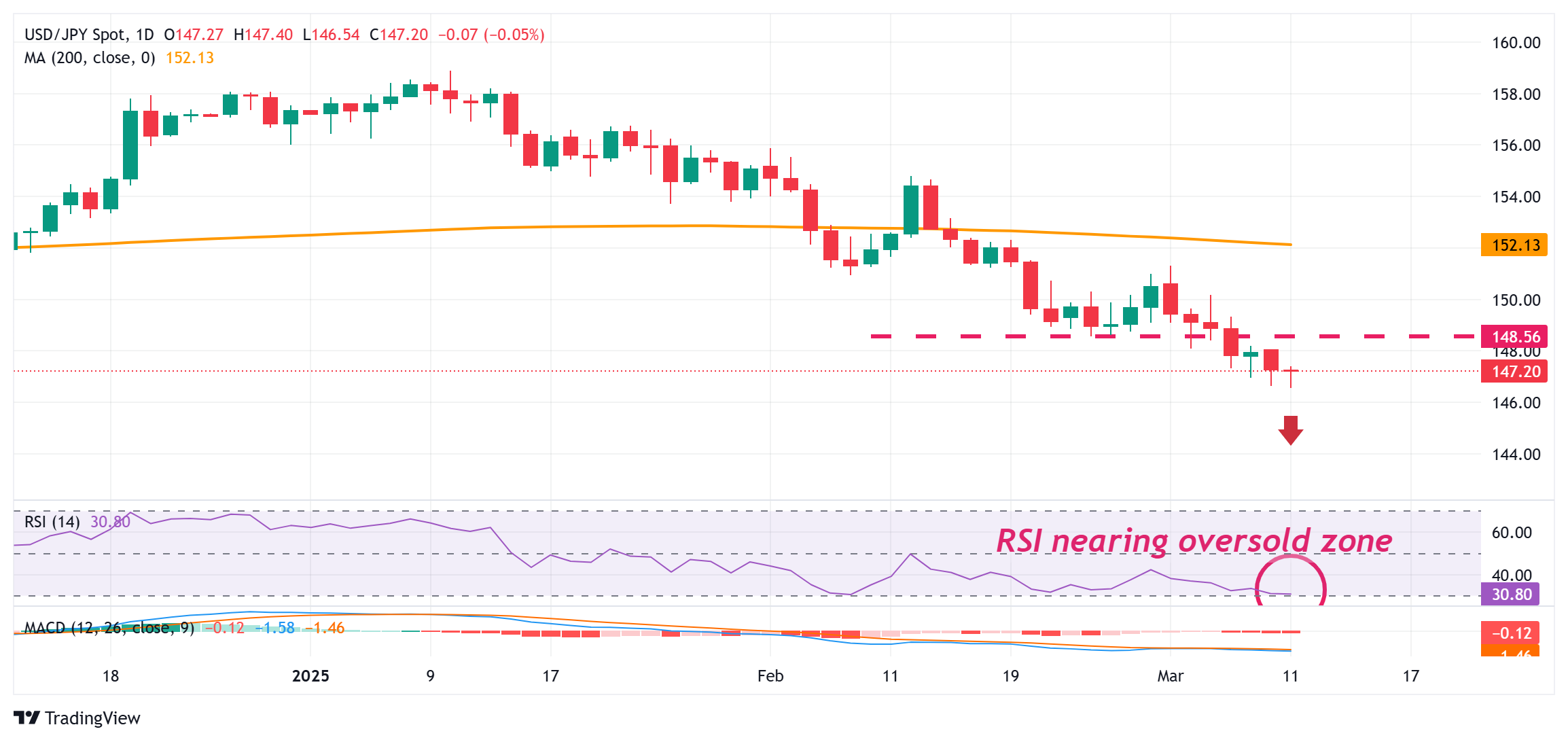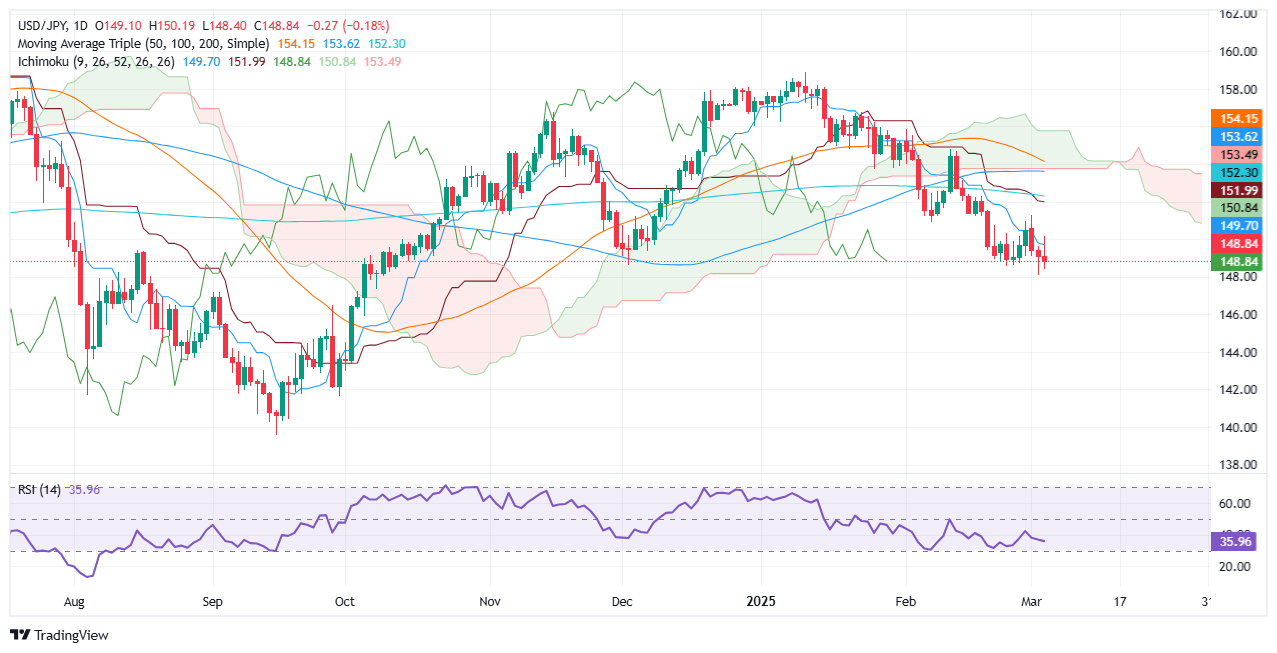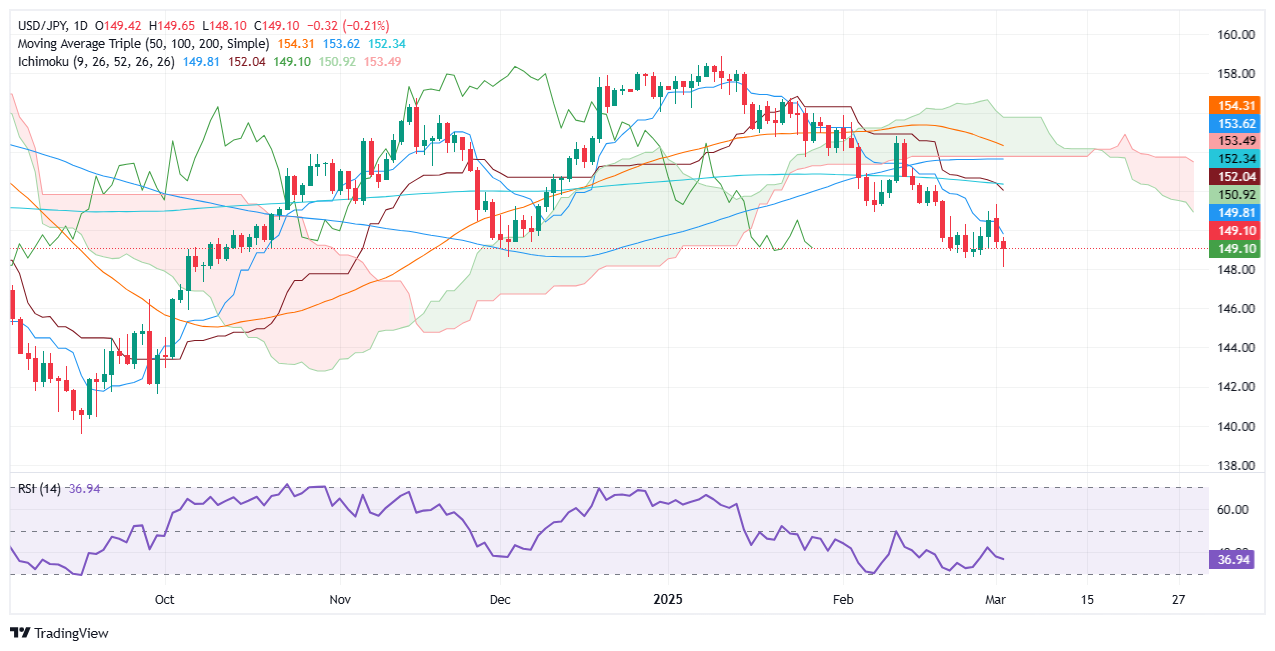- Analytics
- News and Tools
- Quotes
- Chart and quotes for USDJPY
CFD Trading Rate US Dollar vs Japanese Yen (USDJPY)
| Date | Rate | Change | |
|---|---|---|---|
| 09.04.2025 | 146.863 | -0.34% | |
| 08.04.2025 | 147.371 | 0.78% | |
| 07.04.2025 | 146.235 | -1.00% | |
| 06.04.2025 | 147.715 | 0.56% | |
| 03.04.2025 | 146.891 | 0.65% | |
| 02.04.2025 | 145.938 | -1.87% | |
| 01.04.2025 | 148.717 | -0.60% | |
| 31.03.2025 | 149.622 | -0.18% | |
| 30.03.2025 | 149.895 | 0.03% | |
| 27.03.2025 | 149.852 | -0.77% |
Related news
-
11.03.2025 22:11USD/JPY Price Forecast: Rebounds from YTD lows, bulls target 148.00
- Tweezers bottom’ pattern formed at 146.54 signals potential short-term trend reversal.
- RSI flattens, suggesting bearish momentum is losing steam.
- Key upside resistance seen at 148.00; clearance opens the door toward Senkou Span A at 149.79.
The USD/JPY rises as trade tensions loom due to back-and-forth tariff rhetoric between Canada and the United States (US), which initially weighed on the US Dollar. Nevertheless, as both countries agreed to lift tariffs, the pair advanced and traded at 147.77, up 0.34%.
USD/JPY Price Forecast: Technical outlook
USD/JPY formed a ‘tweezers bottom’ two candle chart pattern near the year-to-date (YTD) low of 146.54, hinting that the downtrend seems overextended after dropping from around 158.00 toward the current exchange rates. Despite being bearish, the Relative Strength Index (RSI) is flat, indicating that selling pressure is fading.
For a bearish continuation, USD/JPY needs to clear the YTD low of 146.54. If surpassed the next stop would be the September 30 swing low of 141.64, followed by the September 16 low of 139.58.
Conversely, if USD/JPY climbs above 148.00 a rally towards testing the Senkou Span A at 149.79 is on the cards.
USD/JPY Price Chart – Daily

Japanese Yen PRICE Today
The table below shows the percentage change of Japanese Yen (JPY) against listed major currencies today. Japanese Yen was the strongest against the Euro.
USD EUR GBP JPY CAD AUD NZD CHF USD 0.02% 0.01% 0.00% -0.05% 0.03% 0.00% -0.02% EUR -0.02% -0.01% -0.06% -0.06% 0.00% -0.02% -0.04% GBP -0.01% 0.01% -0.02% -0.05% 0.02% -0.01% -0.02% JPY 0.00% 0.06% 0.02% -0.03% 0.05% 0.00% 0.01% CAD 0.05% 0.06% 0.05% 0.03% 0.08% 0.04% 0.03% AUD -0.03% -0.01% -0.02% -0.05% -0.08% -0.03% -0.04% NZD 0.00% 0.02% 0.00% -0.01% -0.04% 0.03% -0.01% CHF 0.02% 0.04% 0.02% -0.01% -0.03% 0.04% 0.00% The heat map shows percentage changes of major currencies against each other. The base currency is picked from the left column, while the quote currency is picked from the top row. For example, if you pick the Japanese Yen from the left column and move along the horizontal line to the US Dollar, the percentage change displayed in the box will represent JPY (base)/USD (quote).
-
11.03.2025 14:18USD/JPY surges to near 148.00 as Trump tariffs weigh on Japan’s economic outlook
-
11.03.2025 10:15USD/JPY: Upside risk to wages supports the increasing trend in private demand – BBH
-
11.03.2025 10:01USD/JPY: The next technical target is at 146.05 – UOB Group
-
11.03.2025 08:56USD/JPY Price Forecast: Bears turn cautious as focus shifts to US inflation figures
-
10.03.2025 23:01USD/JPY Price Forecast: Extends decline towards 147.00
-
10.03.2025 10:53USD/JPY hits the soft target of 147 – Danske Bank
-
10.03.2025 10:27USD/JPY: Below 147.00, further declines are likely – UOB Group
-
10.03.2025 09:44USD/JPY: BoJ to normalize rates by more than is currently priced-in – BBH
-
07.03.2025 10:35USD/JPY: Room to retest the 147.30 low – UOB Group
-
06.03.2025 10:53USD/JPY has a chance to edge lower – UOB Group
-
06.03.2025 09:36USD/JPY: Consolidation; wait to sell rallies – OCBC
-
05.03.2025 21:54USD/JPY Price Forecast: Slips below 149.00 as sellers gather steam
-
05.03.2025 10:19USD/JPY: To trade between 148.80 and 150.70 – UOB Group
-
05.03.2025 08:48USD/JPY Price Analysis: Tests resistance at 149.50 near nine-day EMA
-
05.03.2025 03:10USD/JPY drifts higher above 149.50 as Trump speaks
-
04.03.2025 22:09USD/JPY Price Forecast: Rebounds but struggles at 150.00 amid bearish pressure
-
04.03.2025 14:57USD/JPY to trade at 145 in the end of the year – Rabobank
-
04.03.2025 14:09USD/JPY refreshes almost five-month low near 148.40 as Fed dovish bets swell
-
04.03.2025 09:30USD/JPY can trade in a range between 148.50 and 150.50 – UOB Group
© 2000-2025. All rights reserved.
This site is managed by Teletrade D.J. LLC 2351 LLC 2022 (Euro House, Richmond Hill Road, Kingstown, VC0100, St. Vincent and the Grenadines).
The information on this website is for informational purposes only and does not constitute any investment advice.
The company does not serve or provide services to customers who are residents of the US, Canada, Iran, The Democratic People's Republic of Korea, Yemen and FATF blacklisted countries.
Making transactions on financial markets with marginal financial instruments opens up wide possibilities and allows investors who are willing to take risks to earn high profits, carrying a potentially high risk of losses at the same time. Therefore you should responsibly approach the issue of choosing the appropriate investment strategy, taking the available resources into account, before starting trading.
Use of the information: full or partial use of materials from this website must always be referenced to TeleTrade as the source of information. Use of the materials on the Internet must be accompanied by a hyperlink to teletrade.org. Automatic import of materials and information from this website is prohibited.
Please contact our PR department if you have any questions or need assistance at pr@teletrade.global.




















